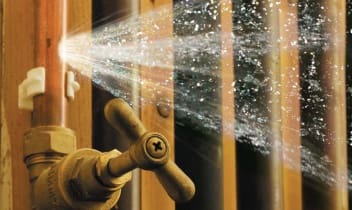Protecting Against Burst Water Lines: Essential Tips to Protect Your Plumbing
Avoiding burst pipes is a critical issue for house owners, especially during cooler months when the risk of cold is enhanced. Executing critical procedures such as appropriate insulation, routine inspections, and maintaining consistent indoor temperature levels can dramatically decrease the likelihood of pipeline failing.
Understand Pipeline Vulnerabilities
Comprehending pipeline vulnerabilities is crucial for reliable pipes upkeep and preventing pricey damages. Several elements contribute to the sensitivity of pipes to bursts, consisting of product structure, age, and ecological problems. Older pipes, specifically those made from galvanized steel or polybutylene, typically break down in time, leading to raised danger of leaks and ruptures.
Temperature fluctuations can additionally dramatically impact pipe integrity. In colder climates, water caught in pipelines can ice up, exerting and increasing pressure on the pipe walls, which may inevitably bring about a burst. High water pressure can strain pipes, especially at joints and bends, increasing the likelihood of failing.

Insulate Water Lines Correctly
Correct insulation of pipelines is vital for stopping freezing and subsequent ruptureds during winter (burst pipe). Insulating your plumbing system properly safeguards against temperature level drops that can result in pricey damages. Begin by identifying susceptible locations where pipelines are subjected to exterior temperatures, such as basements, attic rooms, and exterior walls
Usage foam pipeline insulation sleeves or cover insulation tape around these areas to provide a safety barrier. Ensure that all areas of the pipes, specifically those with restricted heat direct exposure, get ample insulation. Pay special focus to joints and installations, as these are much more prone to freezing.
When shielding, it's necessary to select materials that satisfy regional building ordinance and are suitable for the specific setting. For example, fiberglass insulation is frequently advised for its thermal resistance residential or commercial properties - burst pipe. Furthermore, take into consideration making use of heat cords or tape in severe conditions, which can be connected in to supply additional warmth
Routinely inspect insulated pipelines for any kind of signs of wear or damages, as jeopardized insulation can decrease its efficiency. By taking these proactive steps, you significantly minimize the danger of pipe bursts, making certain a reputable plumbing system throughout the wintertime months.
Maintain Constant Temperature
A secure indoor temperature level is vital for protecting against burst pipes during the frigid months. When temperatures drop, water within pipelines can freeze, broadening and developing stress that may inevitably create the pipelines to ruptured.Using a programmable thermostat can help take care of indoor temperatures effectively, making certain that spaces with pipes stay warm also when the house is unoccupied.
This minor circulation of water can prevent freezing by easing stress within the pipelines. By carrying out these strategies, home owners can dramatically minimize the risk of pipe ruptureds and protect their pipes systems against the harsh wintertime components.
Routinely Check Plumbing
Normal examinations of pipes systems are essential for avoiding burst pipes and keeping total home integrity. Regular checks allow homeowners to recognize possible concerns before they escalate into expensive repair services or significant water damage. Throughout these assessments, it is vital to analyze noticeable pipes for signs of rust, leakages, or put on. Pay unique interest to locations prone to cold, such as basements, attics, and exterior walls.
In addition, checking joints and connections is crucial, as these points are frequently susceptible to leaks. Home owners need to also assess water stress degrees, as too much pressure can stress the plumbing system and boost the threat of pipeline ruptureds.
Take into consideration organizing specialist pipes evaluations at the very least once a year, particularly before winter season, to ensure your system is prepared for cooler temperatures. By being positive in your strategy, you can guard your home against the pricey and disruptive effects of burst pipelines.
Know Emergency Situation Treatments
Comprehending emergency situation click for more procedures is essential for each house owner, particularly after performing normal plumbing assessments. Being prepared for a pipes emergency situation can substantially minimize damage and save prices. First, situate your major water shut-off shutoff; it is usually located near the water meter or where the main line enters your home. Familiarize yourself with its procedure, as shutting off the supply of water promptly can protect against comprehensive flooding.
Next, keep essential devices helpful. A pipes emergency situation set should consist of a wrench, plunger, and towels, as well as a flashlight and a bucket for tiny leaks. In addition, consider having the call information for a relied on plumbing professional readily offered, should the circumstance intensify past your you could try these out control.
If you spot a leakage or burst pipe, immediately shut off the water supply and alert your plumbing technician. Record the damages with photographs for insurance functions. Understand the signs of potential pipes issues, such as unusual water stress variations or damp places on walls
Ultimately, aggressive understanding and swift action are critical in managing pipes emergencies, guaranteeing your home continues to be secured and lessening possible damages.

Conclusion
Finally, protecting against ruptured pipes necessitates a diverse approach that includes understanding pipeline susceptabilities, correct insulation, keeping regular indoor temperature levels, routine assessments, and knowledge of emergency treatments. By carrying out these essential approaches, the threat of pipes failings can be considerably minimized, thereby guaranteeing the long life and effectiveness of the pipes system. Proactive procedures not just safeguard versus possible damage but likewise add to general water conservation her latest blog and the protection of residential or commercial property.
In colder environments, water entraped in pipes can freeze, exerting and increasing stress on the pipe wall surfaces, which might eventually lead to a burst. When temperature levels decline, water within pipelines can freeze, developing and broadening pressure that might ultimately cause the pipelines to ruptured. By executing these techniques, home owners can considerably minimize the risk of pipe bursts and secure their plumbing systems against the rough winter elements.
